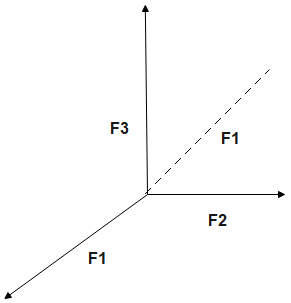Answer
384.9k+ views
Hint: As the issue that particles are stationary is given, then zero will be the result of the forces. We can find the value of force from the relation of the resulting forces. Now, we will use Newton's law of motion equation, which is given below, to calculate the acceleration of the particle.
Formula used:

The equation of Newton's second law of motion is given below
$F=m a$
$\Rightarrow a=\dfrac{F}{m}$
Here, $F$ is the force acting on the particle, $m$ is the mass of the particle and $a$ is the acceleration of the particle.
Complete answer:
Consider a particle of mass $m$ on which three forces $F_{1}, F_{2}$ and $F_{3}$ are acting. Now, when the particle remains
stationary, then the resultant of the three forces will be zero and is given below
$F_{1}+F_{2}+F_{3}=0$
$\Rightarrow F_{1}=-\left(F_{2}+F_{3}\right)$
Therefore, from the above relation, we can say that the magnitude of force $F_{1}$ is equal to the magnitude of the sum of
forces $F_{2}$ and $F_{3}$ i.e. $F_{2}+F_{3},$ but the direction of these forces $F_{2}+F_{3}$ will be opposite to force $F_{1} .$ Now, consider
that the force $F_{1}$ is now removed from the particle of mass $m$, therefore, the magnitude of the force of particle acting
on the mass $m$ will be
$\Rightarrow$ magnitude of $\left(F_{2}+F_{3}\right)$
$\Rightarrow-$ magnitude of $F_{1}$
Now, according to Newton's second law of motion, the acceleration of the particle can be calculated as shown below
$F=m a$
$\Rightarrow a=\dfrac{F}{m}$
Therefore, the acceleration of particle in case of magnitude of force when $F_{1}$ is removed is given below
$a=\dfrac{F_{2}+F_{3}}{m}$
$\therefore a=\dfrac{{{F}_{1}}}{m}$
Therefore, the magnitude of acceleration of the particle is $-\dfrac{F_{1}}{m},$ but the direction of acceleration is opposite to the force $F_{1}$.
Correct option is (A).
Note:
Here, we've got the negative value of acceleration. When the moving object slows down, the acceleration of the particle will be negative. We can also say that when the particle's speed decreases, the acceleration of the particle will be negative.
Formula used:

The equation of Newton's second law of motion is given below
$F=m a$
$\Rightarrow a=\dfrac{F}{m}$
Here, $F$ is the force acting on the particle, $m$ is the mass of the particle and $a$ is the acceleration of the particle.
Complete answer:
Consider a particle of mass $m$ on which three forces $F_{1}, F_{2}$ and $F_{3}$ are acting. Now, when the particle remains
stationary, then the resultant of the three forces will be zero and is given below
$F_{1}+F_{2}+F_{3}=0$
$\Rightarrow F_{1}=-\left(F_{2}+F_{3}\right)$
Therefore, from the above relation, we can say that the magnitude of force $F_{1}$ is equal to the magnitude of the sum of
forces $F_{2}$ and $F_{3}$ i.e. $F_{2}+F_{3},$ but the direction of these forces $F_{2}+F_{3}$ will be opposite to force $F_{1} .$ Now, consider
that the force $F_{1}$ is now removed from the particle of mass $m$, therefore, the magnitude of the force of particle acting
on the mass $m$ will be
$\Rightarrow$ magnitude of $\left(F_{2}+F_{3}\right)$
$\Rightarrow-$ magnitude of $F_{1}$
Now, according to Newton's second law of motion, the acceleration of the particle can be calculated as shown below
$F=m a$
$\Rightarrow a=\dfrac{F}{m}$
Therefore, the acceleration of particle in case of magnitude of force when $F_{1}$ is removed is given below
$a=\dfrac{F_{2}+F_{3}}{m}$
$\therefore a=\dfrac{{{F}_{1}}}{m}$
Therefore, the magnitude of acceleration of the particle is $-\dfrac{F_{1}}{m},$ but the direction of acceleration is opposite to the force $F_{1}$.
Correct option is (A).
Note:
Here, we've got the negative value of acceleration. When the moving object slows down, the acceleration of the particle will be negative. We can also say that when the particle's speed decreases, the acceleration of the particle will be negative.
Recently Updated Pages
How many sigma and pi bonds are present in HCequiv class 11 chemistry CBSE

Why Are Noble Gases NonReactive class 11 chemistry CBSE

Let X and Y be the sets of all positive divisors of class 11 maths CBSE

Let x and y be 2 real numbers which satisfy the equations class 11 maths CBSE

Let x 4log 2sqrt 9k 1 + 7 and y dfrac132log 2sqrt5 class 11 maths CBSE

Let x22ax+b20 and x22bx+a20 be two equations Then the class 11 maths CBSE

Trending doubts
Fill the blanks with the suitable prepositions 1 The class 9 english CBSE

At which age domestication of animals started A Neolithic class 11 social science CBSE

Which are the Top 10 Largest Countries of the World?

Give 10 examples for herbs , shrubs , climbers , creepers

Difference between Prokaryotic cell and Eukaryotic class 11 biology CBSE

Difference Between Plant Cell and Animal Cell

Write a letter to the principal requesting him to grant class 10 english CBSE

Change the following sentences into negative and interrogative class 10 english CBSE

Fill in the blanks A 1 lakh ten thousand B 1 million class 9 maths CBSE



